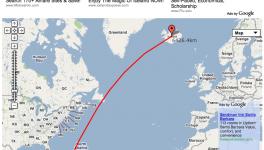The Ig Nobel Prize for Economics or a Cop Out?
The Ig Nobel prizes are distributed each year, an event of fun and also making people think on what is important in science. This year's event drew attention from the media worldwide, focussing on improbable research such as the use of panda's poo for improving biodegradability of rubbish and the now famous wonder bra that doubles up as instant two gas masks in case of a chemical gas attack. In this exciting mix, the prize that has drawn much less attention is the one given to Iceland bankers for the creative economics that resulted in pledging their banks into Iceland's bankruptcy. This has also has created a whole host of Icelandic jokes – such as what is the capital of Iceland. And no, the answer is not Reykjavik, but $20!
I am afraid that the Iceland bankers, stupid as they undoubtedly were, do not deserve the credit being given to them. The instruments that lead to the demise of Lehman Brothers and the bankruptcy of a host of entities including Iceland, had impeccable pedigree. Some of the key figures whose work lead to the models used, got the Noble prizes for Economics in 1990 -- Harry Markowitz, William Sharpe, and Merton Miller. Business Week, (Christopher Farrel, October 11, 2004, http://www.businessweek.com/magazine/content/04_41/b3903015_mz072.htm) in its anniversary celebration series of Great Innovators, hailed them as “Three Wise Men of Finance”, whose work on “risk and return revolutionized investing forever”. The other figures were Fischer Black and Myron Scholes. Scholes and Merton also got the Nobel prize in 1997, as Black had died by then and Nobel is not given posthumously.
As the world has now learnt, this revolution hailed by Business Week, has already cost the American public approximately 4.7 trillion dollars, with the possibility of this price tag rising to a possible 24 trillion (report to the US Congress from special inspector general Neil Barofsky, the overseer of the bank bailout program). Just to put the figures in perspective, the US GDP is about 14 trillion, and a price tag of 24 trillion means that Wall Street would be underwritten to the tune of $80,000 by every man, woman and child in America. Some revolution indeed!
I do find it very unfair that while the guys that built the house of cards called risk analysis should get the Nobel, while the Icelandic bankers get the Ig Nobel for merely living in it. Iceland bankers were following what every financial institution was also doing and what was being hailed by the financial papers as the greatest discovery after sliced bread. Nassim Taleb of the Black Swan fame, has, as one of his recommendations for avoiding future meltdowns, the scrapping of the Nobel prize for economics! The Ig Noble sponsors would have done better to have bestowed this year's prize to the wise gentlemen who got Nobel prizes for sinking the global economy. Or to the Committee that gave them their Noble prizes in the first place. Giving to Iceland bankers, entertaining as it undoubtedly is, is a complete cop out!
The financial innovations created by these eminent economists were responsible for much of the housing and security “bubble”. The financial system today, today rests on such “innovations”. The financialisation of the economy means that the real economy, where real goods and real services are exchanged, and the world of finance where derivatives and other instruments are exchanged, are treated the same way. A few set of numbers computed from the sum of assets, both real and “assets” derived from such real assets -- the derivatives – are “computed” from such complex financial models. As the real world recedes from our vision, the shadowy world of finance with its obscure and complex instruments comes to dominate. Instead of the real economy telling us what we are producing and consuming, we get the Sensex, the bond market, the money market, the commodity market and so on. When these markets go up, the financial institutions make a killing; more than 40% of corporate profits of the US in 2006 came from the earnings of the financial institutions. When the markets collapse, the institutions line up for bailouts in the best tradition of capitalism – socialisation of losses and privatisation of profits.
Various scholarly articles have exposed the problem with the mathematical models – they assumed that extreme fluctuations are unlikely and did not take them into account in their models.
Mandelbrot, the famous mathematician, who is co-founder of the mathematics of chaos and creator of fractal geometry, says (Benoit Mandelbrot, How Fractals Can Explain What's Wrong with Wall Street, http://www.scientificamerican.com/article.cfm?id=multifractals-explain-…), “But the picture it presents does not reflect reality, if one agrees that major events are part of the remaining 5 percent. An inescapable analogy is that of a sailor at sea. If the weather is moderate 95 percent of the time, can the mariner afford to ignore the possibility of a typhoon”? (Emphasis added).
Mandelbrot and Talib (How the Finance Gurus get the risks all wrong, www.fooledbyrandomness.com/fortune.pdf) have also pointed out that the risk models consider movement of prices to be models of “random walks” – each step consisting of “baby steps”. However, the stock market routinely shows such behaviour – huge discontinuous jumps in either direction – and yet the models disregarded them as merely “outliers”
The models also added risks of various kinds, again using short term past data of the boom period (the formula was called Gaussian Copula function) and did not really account for real risks.
But all this is not what sank the global economy. What sank it was the greed of the financial companies. Wall Street and the regulators did not want to hear that risks are not easy to calculate and prudence demands dampening of the speculative market, creating enough reserves within the system, and a much stronger regulatory regime. This is what lead to various shoddy risk models with even more shoddier mathematics. It was the tail of Wall Street's greed that wagged the mathematical dog and not as the Wired puts it about the risk formula, “The Formulae that Killed Wall Street” (Wired: http://www.wired.com/techbiz/it/magazine/17-03/wp_quant?currentPage=all). And let us not forget where all this mathematical “innovation” lead to – extracting huge amounts of rents from the market or redistribution of wealth on a grand scale.
Get the latest reports & analysis with people's perspective on Protests, movements & deep analytical videos, discussions of the current affairs in your Telegram app. Subscribe to NewsClick's Telegram channel & get Real-Time updates on stories, as they get published on our website.
















